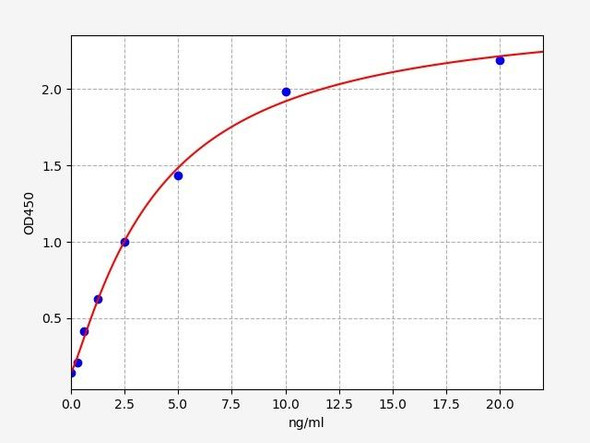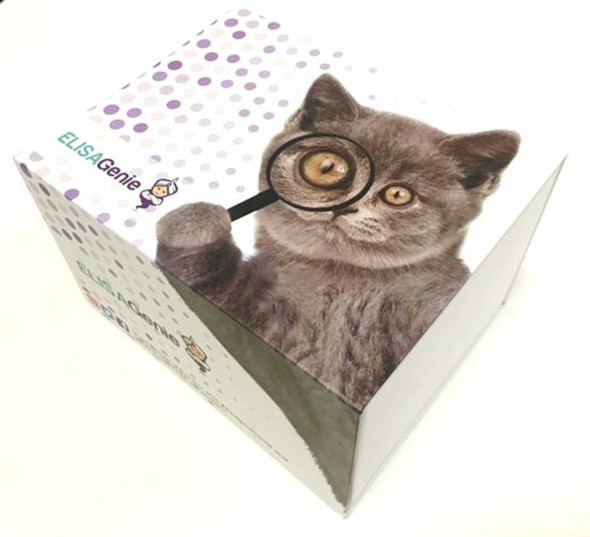Human Metabolism ELISA Kits
Human CETP (Cholesteryl Ester Transfer Protein) CLIA Kit (HUES00460)
- SKU:
- HUES00460
- Product Type:
- ELISA Kit
- ELISA Type:
- CLIA Kit
- Size:
- 96 Assays
- Sensitivity:
- 37.5pg/mL
- Range:
- 62.5-4000pg/mL
- ELISA Type:
- Sandwich
- Reactivity:
- Human
- Sample Type:
- Serum, plasma and other biological fluids
- Research Area:
- Metabolism
Description
| Assay type: | Sandwich |
| Format: | 96T |
| Assay time: | 4.5h |
| Reactivity: | Human |
| Detection method: | Chemiluminescence |
| Detection range: | 62.50-4000 pg/mL |
| Sensitivity: | 37.50 pg/mL |
| Sample volume: | 100µL |
| Sample type: | Serum, plasma and other biological fluids |
| Repeatability: | CV < 15% |
| Specificity: | This kit recognizes Human CETP in samples. No significant cross-reactivity or interference between Human CETP and analogues was observed. |
This kit uses Sandwich-CLIA as the method. The micro CLIA plate provided in this kit has been pre-coated with an antibody specific to Human CETP. Standards or samples are added to the appropriate micro CLIA plate wells and combined with the specific antibody. Then a biotinylated detection antibody specific for Human CETP and Avidin-Horseradish Peroxidase (HRP) conjugate are added to each micro plate well successively and incubated. Free components are washed away. The substrate solution is added to each well. Only those wells that contain Human CETP, biotinylated detection antibody and Avidin-HRP conjugate will appear fluorescence. The Relative light unit (RLU) value is measured spectrophotometrically by the Chemiluminescence immunoassay analyzer. The RLU value is positively associated with the concentration of Human CETP. The concentration of Human CETP in the samples can be calculated by comparing the RLU of the samples to the standard curve.
| UniProt Protein Function: | CETP: Involved in the transfer of insoluble cholesteryl esters in the reverse transport of cholesterol. Defects in CETP are the cause of hyperalphalipoproteinemia type 1 (HALP1). Affected individuals show high levels of alpha-lipoprotein (high density lipoprotein/HDL). Belongs to the BPI/LBP/Plunc superfamily. BPI/LBP family. 2 isoforms of the human protein are produced by alternative splicing. |
| UniProt Protein Details: | Protein type:Lipid-binding; Secreted; Secreted, signal peptide; Vesicle Chromosomal Location of Human Ortholog: 16q21 Cellular Component: extracellular space; extracellular region; vesicle Molecular Function:lipid transporter activity; phospholipid transporter activity; cholesterol transporter activity; cholesterol binding; phosphatidylcholine binding; lipid binding; triglyceride binding Biological Process: cholesterol metabolic process; receptor-mediated endocytosis; cholesterol transport; lipid homeostasis; lipoprotein metabolic process; lipid transport; phosphatidylcholine metabolic process; cholesterol homeostasis; reverse cholesterol transport; triacylglycerol metabolic process; phospholipid transport; triacylglycerol transport; transmembrane transport; phospholipid homeostasis Disease: Hyperalphalipoproteinemia 1 |
| NCBI Summary: | The protein encoded by this gene is found in plasma, where it is involved in the transfer of cholesteryl ester from high density lipoprotein (HDL) to other lipoproteins. Defects in this gene are a cause of hyperalphalipoproteinemia 1 (HALP1). Two transcript variants encoding different isoforms have been found for this gene. [provided by RefSeq, Oct 2013] |
| UniProt Code: | P11597 |
| NCBI GenInfo Identifier: | 71153497 |
| NCBI Gene ID: | 1071 |
| NCBI Accession: | P11597. 2 |
| UniProt Secondary Accession: | P11597,Q13987, Q13988, Q53YZ1, |
| UniProt Related Accession: | P11597 |
| Molecular Weight: | 47,787 Da |
| NCBI Full Name: | Cholesteryl ester transfer protein |
| NCBI Synonym Full Names: | cholesteryl ester transfer protein, plasma |
| NCBI Official Symbol: | CETP |
| NCBI Official Synonym Symbols: | BPIFF; HDLCQ10 |
| NCBI Protein Information: | cholesteryl ester transfer protein; lipid transfer protein I; BPI fold containing family F |
| UniProt Protein Name: | Cholesteryl ester transfer protein |
| UniProt Synonym Protein Names: | Lipid transfer protein I |
| Protein Family: | Cholesteryl ester transfer protein |
| UniProt Gene Name: | CETP |
| UniProt Entry Name: | CETP_HUMAN |
As the RLU values of the standard curve may vary according to the conditions of the actual assay performance (e. g. operator, pipetting technique, washing technique or temperature effects), the operator should establish a standard curve for each test. Typical standard curve and data is provided below for reference only.
| Concentration (pg/mL) | RLU | Average | Corrected |
| 4000 | 53733 64429 | 59081 | 59046 |
| 2000 | 27120 28598 | 27859 | 27824 |
| 1000 | 14388 12580 | 13484 | 13449 |
| 500 | 6091 7119 | 6605 | 6570 |
| 250 | 3399 3087 | 3243 | 3208 |
| 125 | 1700 1462 | 1581 | 1546 |
| 62.50 | 739 771 | 755 | 720 |
| 0 | 35 35 | 35 | -- |
Precision
Intra-assay Precision (Precision within an assay): 3 samples with low, mid range and high level Human CETP were tested 20 times on one plate, respectively.
Inter-assay Precision (Precision between assays): 3 samples with low, mid range and high level Human CETP were tested on 3 different plates, 20 replicates in each plate.
| Intra-assay Precision | Inter-assay Precision | |||||
| Sample | 1 | 2 | 3 | 1 | 2 | 3 |
| n | 20 | 20 | 20 | 20 | 20 | 20 |
| Mean (pg/mL) | 208.23 | 512.08 | 1563.10 | 194.82 | 547.85 | 1624.86 |
| Standard deviation | 17.14 | 54.38 | 104.57 | 23.05 | 64.76 | 155.99 |
| C V (%) | 8.23 | 10.62 | 6.69 | 11.83 | 11.82 | 9.60 |
Recovery
The recovery of Human CETP spiked at three different levels in samples throughout the range of the assay was evaluated in various matrices.
| Sample Type | Range (%) | Average Recovery (%) |
| Serum (n=5) | 87-99 | 92 |
| EDTA plasma (n=5) | 96-112 | 104 |
| Cell culture media (n=5) | 96-111 | 101 |
Linearity
Samples were spiked with high concentrations of Human CETP and diluted with Reference Standard & Sample Diluent to produce samples with values within the range of the assay.
| Serum (n=5) | EDTA plasma (n=5) | Cell culture media (n=5) | ||
| 1:2 | Range (%) | 89-101 | 96-111 | 101-117 |
| Average (%) | 96 | 103 | 107 | |
| 1:4 | Range (%) | 86-100 | 90-103 | 85-98 |
| Average (%) | 92 | 95 | 90 | |
| 1:8 | Range (%) | 99-115 | 87-101 | 99-113 |
| Average (%) | 105 | 94 | 107 | |
| 1:16 | Range (%) | 89-103 | 87-99 | 96-108 |
| Average (%) | 95 | 93 | 102 |
An unopened kit can be stored at 4°C for 1 month. If the kit is not used within 1 month, store the items separately according to the following conditions once the kit is received.
| Item | Specifications | Storage |
| Micro CLIA Plate(Dismountable) | 8 wells ×12 strips | -20°C, 6 months |
| Reference Standard | 2 vials | |
| Concentrated Biotinylated Detection Ab (100×) | 1 vial, 120 µL | |
| Concentrated HRP Conjugate (100×) | 1 vial, 120 µL | -20°C(shading light), 6 months |
| Reference Standard & Sample Diluent | 1 vial, 20 mL | 4°C, 6 months |
| Biotinylated Detection Ab Diluent | 1 vial, 14 mL | |
| HRP Conjugate Diluent | 1 vial, 14 mL | |
| Concentrated Wash Buffer (25×) | 1 vial, 30 mL | |
| Substrate Reagent A | 1 vial, 5 mL | 4°C (shading light) |
| Substrate Reagent B | 1 vial, 5 mL | 4°C (shading light) |
| Plate Sealer | 5 pieces | |
| Product Description | 1 copy | |
| Certificate of Analysis | 1 copy |
- Set standard, test sample and control (zero) wells on the pre-coated plate and record theirpositions. It is recommended to measure each standard and sample in duplicate. Note: addall solutions to the bottom of the plate wells while avoiding contact with the well walls. Ensuresolutions do not foam when adding to the wells.
- Aliquot 100µl of standard solutions into the standard wells.
- Add 100µl of Sample / Standard dilution buffer into the control (zero) well.
- Add 100µl of properly diluted sample (serum, plasma, tissue homogenates and otherbiological fluids. ) into test sample wells.
- Cover the plate with the sealer provided in the kit and incubate for 90 min at 37°C.
- Aspirate the liquid from each well, do not wash. Immediately add 100µL of BiotinylatedDetection Ab working solution to each well. Cover the plate with a plate seal and gently mix. Incubate for 1 hour at 37°C.
- Aspirate or decant the solution from the plate and add 350µL of wash buffer to each welland incubate for 1-2 minutes at room temperature. Aspirate the solution from each well andclap the plate on absorbent filter paper to dry. Repeat this process 3 times. Note: a microplatewasher can be used in this step and other wash steps.
- Add 100µL of HRP Conjugate working solution to each well. Cover with a plate seal andincubate for 30 min at 37°C.
- Aspirate or decant the solution from each well. Repeat the wash process for five times asconducted in step 7.
- Add 100µL of Substrate mixture solution to each well. Cover with a new plate seal andincubate for no more than 5 min at 37°C. Protect the plate from light.
- Determine the RLU value of each well immediately.






